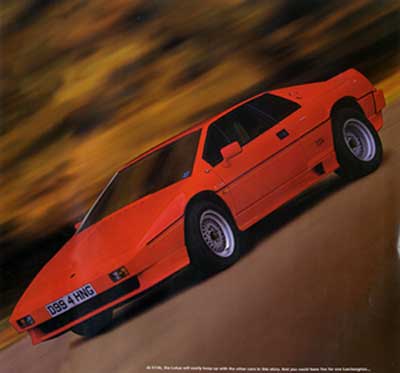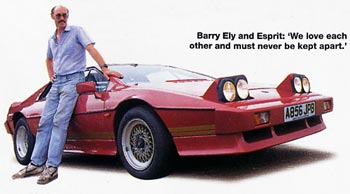

Your First Supercar
Up to £10,000: Lotus Esprit Turbo
Barry Ely is not quite your average Esprit owner. He buys them, sells them, makes a business out of them. Thing is, he loves them, and that qualifies him for our Supercar-Addict criteria. The 1984 Turbo Esprit you see below is a perfect example of what we’re talking about. Barry has owned this car four times. He first bought it in 1985, has sold it three times and has looked after it for each of its owners. Now it’s up for sale again. ‘When you come to sell it,’ he has said to each of his buyers, ‘I’ll buy it back.’
Even now, it has covered only 30,000 miles. It’s yours for £12,495, but Barry concedes you can get a usable Turbo Esprit for under £10K. ‘But that might be a bit scruffy,’ he says.
The seeds of Barry’s desire were sown back in 1975, when he saw the first non-turbo Esprit, the S1, at the Motor Show ‘It was a pure wedge, Wolfrace wheels, like something from outer space. I knew I wanted one then, but I was still an apprentice.
‘Later I became a Lotus specialist, drove customers’ cars and desperately wanted one of my own. Eventually I got an S2 — I didn’t want an S1, because you should never buy the first version of a new Lotus design — and then this Turbo.

‘The
handling is second to none.
And it is very very fast’
Barry
Ely. Esprit Turbo owner
‘It’s the first Turbo I ever owned. I desperately wanted an early Turbo, but not one of the first dry-sump cars. I saw this one advertised, 7,000 miles and one owner, and I’ve still got its original sales invoice.’
So what is about the Esprit Turbo? ‘The shape. It’s superb, hasn’t been bettered. That Giugiaro styling, it’s timeless, aggressive, classic. Some of us won’t have anything else, and I’m in a Club Lotus splinter group called the Giugiaro Esprit Group.’ Barry warms to his theme. ‘The Turbo bodywork — the deeper sills, the louvres on the tailgate, the deeper front spoiler, the bigger rear spoiler — it makes it a real muscle-car.
‘It’s built like a racing car, with all the weight in the right place, and the handling is second to none. And it’s very, very quick. In 1984 the Turbo still had the low-compression engine, but it still did 0-60 in 5.5 seconds.’
Nevertheless, four owners in only 30,000 miles? There are good excuses. ‘The first man was semi-retired, and he loved it, but his wife ran off with his brother and he lost interest. Then it went to a man who was only five feet tall. I made a special seat but he was a Porsche fan really — he even called his daughter Portia — so I sold him a 911. The next owner’s wife refused to drive it and he lost heart. Now it’s looking for another caring owner. If that’s you, Telephone Barry on 0802 558 3221.
Is Barry talking nonsense?
Not really. Some say Esprits are glorified kit-cars with all the aggro that entails, but it's not really true of the Turbo. You get a remarkable car for your £10,000 — has a galvanised chassis, a very tough glassfibre body, a reliable engine if properly serviced, and proper double-wishbone rear suspension, unlike the semi-system (using the driveshaft as the upper link) of the first Esprits.
But the Esprit is a four-pot. Surely supercars should have
at least six cylinders?
Good point. The exhaust note is barely more alluring than a Ford Mondeo’s
— wastegate flutter apart. But there are few ways of going faster for
less money: the handling resembles a track-racer (abeit more forgiving, with
a surprisingly supple ride), and there’s the overpowering visual drama
of the thing. You see, the Esprit works on two levels: it's the Colin Chapman-conceived
speed machine, pure and functional with its mid-mounted engine, Iie-back driving
position and minimal concessions to red-road usability, yet it’s also
a bold, brash, outrageous-looking statement of Swampy-squashing assertiveness.
Will it go bang?
Little-used examples of early Turbos can seize their wastegates shut, which
gives a welcome increase in power for a short time before the pistons break
up. The Citroen transaxle is fragile, too, though the post-1987 car’s
Renault unit can be made to fit, and the exhaust manifold can crack. Myriad
minor ailments will also afflict an ageing Esprit, but what the heck? While
you’re happily posing, you can always pretend you bought the Esprit for
the purity of its concept.
|
Engine:
4-cyl, 2174cc, dohc 16V, longitudinal md-mounted |
|
|